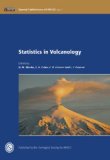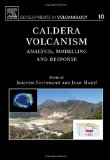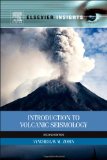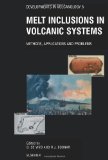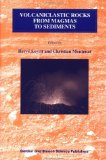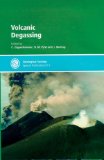
|
Volcanic Degassing
Humans have long marvelled at (and feared) the odorous and colourful manifestations of volcanic emissions, and, in some cases, have harnessed them for their economic value. The degassing process responsible for these phenomena is now understood to be one of the key factors influencing the timing and nature of volcanic eruptions. Moreover the surface emissions of these volatiles can have profound effects on the atmospheric and terrestrial environment, and climate. Even more fundamental are the relationships between the history of planetary outgassing, differentiation of the Earth's interior, chemistry of the atmosphere and hydrosphere, and the origin and evolution of life. This book provides a compilation of 23 papers that investigate the behaviour of volatiles in magma, the feedbacks between degassing and magma dynamics, and the composition, flux, and environmental, atmospheric and climatic impacts of volcanic gas emissions. |
|
Statistics in Volcanology
Statistics in Volcanology is a comprehensive guide to modern statistical methods applied in volcanology written by today's leading authorities. The volume aims to show how the statistical analysis of complex volcanological data sets, including time series, and numerical models of volcanic processes can improve our ability to forecast volcanic eruptions. Specific topics include the use of expert elicitation and Bayesian methods in eruption forecasting, statistical models of temporal and spatial patterns of volcanic activity, analysis of time series in volcano seismology, probabilistic hazard assessment, and assessment of numerical models using robust statistical methods. Also provided are comprehensive overviews of volcanic phenomena, and a full glossary of both volcanological and statistical terms. Statistics in Volcanology is essential reading for advanced undergraduates, graduate students, and research scientists interested in this multidisciplinary field. |
|
The Physics of Explosive Volcanic Eruptions
A review, consisting of 8 papers with 120 illustrations, this book aims to present an outline of the editors' current understanding of several aspects of the physics of volcanic eruptions. The aspects covered include the physical characterization of silicic magma relevant to explosive volcanism, vesiculation of silicic magmas, conduit flow and fragmentation, gas loss from magmas during eruption, observations and models of eruption columns, tephra dispersal, pyroclastic density currents, and future research directions. By no means a complete outline nor one that reflects all important issues regarding explosive volcanic eruption physics, the papers in this book reflect the research interests of the group of writers chosen for this review. As such there is a notable bias towards eruption of silicic magmas, which is fair considering that these magmas are perhaps the most common in explosive magmatic eruptions. Readers will find this book to be a useful guide to issues that have been recent topics of considerable attention in volcano physics. Because of the generous citation of background research, each paper in itself is an excellent starting point for students and professionals to rapidly grasp the salient topics, those that have experimental and theoretical as well as observational basis for discussion. |
|
Caldera Volcanism: Analysis, Modelling and Response
This volume aims at providing answers to some puzzling questions concerning the formation and the behavior of collapse calderas by exploring our current understanding of these complex geological processes. Addressed are problems such as: - How do collapse calderas form? - What are the conditions to create fractures and slip along them to initiate caldera collapse and when are these conditions fulfilled? - How do these conditions relate to explosive volcanism? - Most products of large caldera-forming eruptions show evidence for pre-eruptive reheating. Is this a pre-requisite to produce large volume eruptions and large calderas? - What are the time-scales behind caldera processes? - How long does it take magma to reach conditions ripe enough to generate a caldera-forming eruption? - What is the mechanical behavior of magma chamber walls during caldera collapse? Elastic, viscoelastic, or rigid? - Do calderas form by underpressure following a certain level of magma withdrawal from a reservoir, or by magma chamber loading due to deep doming (underplating), or both? - How to interpret unrest signals in active caldera systems? - How can we use information from caldera monitoring to forecast volcanic phenomena? In the form of 14 contributions from various disciplines this book samples the state-of-the-art of caldera studies and identifies still unresolved key issues that need dedicated cross-boundary and multidisciplinary efforts in the years to come. |
|
Volcanoes: Global Perspectives
Volcanoes are essential elements in the delicate global balance of elemental forces that govern both the dynamic evolution of the Earth and the nature of Life itself. Without volcanic activity, life as we know it would not exist on our planet. Although beautiful to behold, volcanoes are also potentially destructive, and understanding their nature is critical to prevent major loss of life in the future. Richly illustrated with over 300 original color photographs and diagrams the book is written in an informal manner, with minimum use of jargon, and relies heavily on first-person, eye-witness accounts of eruptive activity at both "red" (effusive) and "grey" (explosive) volcanoes to illustrate the full spectrum of volcanic processes and their products. Decades of teaching in university classrooms and fieldwork on active volcanoes throughout the world have provided the authors with unique experiences that they have distilled into a highly readable textbook of lasting value. Questions for Thought, Study, and Discussion, Suggestions for Further Reading, and a comprehensive list of source references make this work a major resource for further study of volcanology. |
|
Introduction to Volcanic Seismology, 2nd ed
Volcanic seismology represents the main, and often the only, tool to forecast volcanic eruptions and to monitor the eruption process. This book describes the main types of seismic signals at volcanoes, their nature and spatial and temporal distributions at different stages of eruptive activity. Following from the success of the first edition, published in 2003, the second edition consists of 19 chapters including significant revision and five new chapters. Organized into four sections, the book begins with an introduction to the history and topic of volcanic seismology, discussing the theoretical and experimental models that were developed for the study of the origin of volcanic earthquakes. The second section is devoted to the study of volcano-tectonic earthquakes, giving the theoretical basis for their occurrence and swarms as well as case stories of volcano-tectonic activity associated with the eruptions at basaltic, andesitic, and dacitic volcanoes. There were 40 cases of volcanic eruptions at 20 volcanoes that occurred all over the world from 1910 to 2005, which are discussed. General regularities of volcano-tectonic earthquake swarms, their participation in the eruptive process, their source properties, and the hazard of strong volcano-tectonic earthquakes are also described. The third section describes the theoretical basis for the occurrence of eruption earthquakes together with the description of volcanic tremor, the seismic signals associated with pyroclastic flows, rockfalls and lahars, and volcanic explosions, long-period and very-long-period seismic signals at volcanoes, micro-earthquake swarms, and acoustic events. The final section discuss the mitigation of volcanic hazard and include the methodology of seismic monitoring of volcanic activity, the examples of forecasting of volcanic eruptions by seismic methods, and the description of seismic activity in the regions of dormant volcanoes. |
|
Melt Inclusions in Volcanic Systems: Methods, Applications and Problems
Melt inclusions provide a unique record of the physical and chemical processes operating in active magma chambers associated with volcanic systems. This book includes a summary of modern techniques used to study and interpret melt inclusions in volcanic rocks, as well as descriptive studies of specific volcanoes. These various studies document the enormous potential for melt inclusions to provide a window into the dynamics of active magma chambers. 'Melt Inclusions in Volcanic Systems' gives the most up-to-date summary of research on the application of melt inclusions in studies of active and fossil volcanic systems, as well as suggestions for future research in this area. |
|
Arc Volcanism: Physics and Tectonics
|
|
Volcaniclastic Rocks, from Magmas to Sediments
This volume is an excellently written and beautifully illustrated textbook compiled by a multidisciplinary group of experts examining the production, transport and deposition of volcaniclasts (tephra and epiclasts) as well as their economic geology. |
























